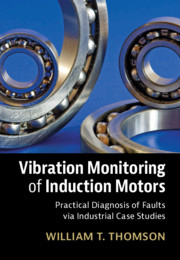Book contents
- Vibration Monitoring of Induction Motors
- Vibration Monitoring of Induction Motors
- Copyright page
- Contents
- Preface
- About the Author
- Acknowledgements
- Biographies of Personnel in the Acknowledgements
- Nomenclature
- Acronyms and Abbreviations
- Relevant Units of Equivalence Useful for this Book
- 1 Vibration Monitoring of Induction Motors and Case Histories on Shaft Misalignment and Soft Foot
- 2 Rolling Element Bearings for Induction Motors
- 3 Types of Defects in Rolling Element Bearings
- 4 Introduction to Vibration Spectrum Analysis to Diagnose Faults in Rolling Element Bearings in Induction Motors
- 5 Industrial Case Histories on VSA to Diagnose Cage Faults in Rolling Element Bearings of SCIMs
- 6 Industrial Case Histories – VSA Detected Inner and Outer Race Faults in Rolling Element Bearings in SCIMS
- 7 Industrial Case Histories – VSA Diagnosed False Brinelling and Problems in Cylindrical Roller Bearings in SCIMs
- 8 Industrial Case Histories on VSA to Diagnose Miscellaneous Faults in Rolling Element Bearings in SCIMS
- 9 Industrial Case Histories on Vibration Measurements and Analysis Applied to Large Induction Motors with Sleeve Bearings
- 10 Industrial Case Histories on Magnetic Forces and Vibration from Induction Motors
- 11 Miscellaneous Industrial Case Histories on Vibration Analysis Applied to Induction Motor Drives
- 12 Overview of Key Features of Vibration Monitoring of SCIMs
- Index
- References
10 - Industrial Case Histories on Magnetic Forces and Vibration from Induction Motors
Published online by Cambridge University Press: 17 February 2021
- Vibration Monitoring of Induction Motors
- Vibration Monitoring of Induction Motors
- Copyright page
- Contents
- Preface
- About the Author
- Acknowledgements
- Biographies of Personnel in the Acknowledgements
- Nomenclature
- Acronyms and Abbreviations
- Relevant Units of Equivalence Useful for this Book
- 1 Vibration Monitoring of Induction Motors and Case Histories on Shaft Misalignment and Soft Foot
- 2 Rolling Element Bearings for Induction Motors
- 3 Types of Defects in Rolling Element Bearings
- 4 Introduction to Vibration Spectrum Analysis to Diagnose Faults in Rolling Element Bearings in Induction Motors
- 5 Industrial Case Histories on VSA to Diagnose Cage Faults in Rolling Element Bearings of SCIMs
- 6 Industrial Case Histories – VSA Detected Inner and Outer Race Faults in Rolling Element Bearings in SCIMS
- 7 Industrial Case Histories – VSA Diagnosed False Brinelling and Problems in Cylindrical Roller Bearings in SCIMs
- 8 Industrial Case Histories on VSA to Diagnose Miscellaneous Faults in Rolling Element Bearings in SCIMS
- 9 Industrial Case Histories on Vibration Measurements and Analysis Applied to Large Induction Motors with Sleeve Bearings
- 10 Industrial Case Histories on Magnetic Forces and Vibration from Induction Motors
- 11 Miscellaneous Industrial Case Histories on Vibration Analysis Applied to Induction Motor Drives
- 12 Overview of Key Features of Vibration Monitoring of SCIMs
- Index
- References
Summary
Chapter 10 presents the fundamental causes of electromagnetic forces and consequential vibration in induction motors, including the twice supply frequency component and its harmonics, and the classical rotor slot passing frequency components.
- Type
- Chapter
- Information
- Vibration Monitoring of Induction MotorsPractical Diagnosis of Faults via Industrial Case Studies, pp. 208 - 240Publisher: Cambridge University PressPrint publication year: 2020



